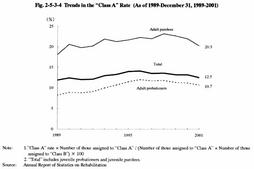| Previous Next Index Image Index Year Selection | |
|
|
3 Various measures (1) Classified treatment system Classified treatment system was introduced in 1971 as a system in which probation officers would actively implement planned and direct measures for parolees and probationers, especially those who have grave problems with their predispositions and environments, by making effective use of their expertise. In this system, probationers and parolees are divided into "Class A" or "Class B" depending on the difficulty of their treatment under certain criteria in line with scientific views. With respect to "Class A" probationers and parolees who are judged to have a number of problems and to be difficult to treat, probation officers communicate with probationers and parolees, their families and other persons concerned to give them direct advice as well as undertake active liaison with authorities concerned. Probation officers shall also undertake liaison and discussion positively and efficiently with volunteer probation officers.
Fig. 2-5-3-4 shows the trends in the rate of parolees and probationers who were assigned to "Class A" since 1989. Since 1999, the rate of "Class A" has been slightly decreasing for both adult parolees and adult probationers, but the rate for parolees still maintain the 20% mark after surpassing it in 1992. Fig. 2-5-3-4 Trends in the "Class A" Rate (As of 1989-December 31, 1989-2001) (2) Categorized treatment system Categorized treatment is a system whereby the problems and other characteristics of probationers and parolees are divided into 10 categories according to the nature of the crime or delinquency, environmental conditions and other circumstances. Concrete treatment guidelines are set for each category and effective treatment is implemented focusing on these characteristics. This system was introduced in 1990 for the purpose of improving treatment measures from a different perspective from the classified treatment system. As of December 31, 2001, 26.3% of adult parolees and 20.4% of adult probationers were assigned to the "Stimulant drug offense" category, 3.3% and 4.5% to the "Connection to organized crime groups" category, and 4.7% and 4.3% to the "Sexual offense" category respectively (Rehabilitation Bureau, Ministry of Justice).
(3) Probationary supervision for long-term sentenced parolees Special measures to enhance and reinforce probationary supervision are taken for long-term sentenced parolees including life-imprisonment parolees (see Section 2, 3 (2) of this Chapter for parole examinations for long-term sentenced inmates).
Such long-term sentenced parolees shall be accommodated in halfway houses for a month from the beginning of parole, if such treatment is deemed to be reasonable for them by the Regional Parole Board and they give their consents. This intermediate treatment, whose purpose is to provide parolees with training for daily living and occupational support and to enable them to have a prompt and smooth return to life in the society, is implemented in a planned and concentrated manner. In 2001, 110 parolees were subject to intermediate treatment (Rehabilitation Bureau, Ministry of Justice). In July 2000, a new treatment scheme started focusing on the 1 year after the release on parole (or the period of parole if it is shorter than 1 year) as the key treatment period during which direct participation by probation officers are reinforced. Furthermore, other treatments started to be implemented such as continuing to provide guidance and advice from the commencement of probationary supervision with regard to specific means to pay compensation for damage or consolation money to victims and bereaved family members of deceased victims. |
